人体的隐喻(十)
- 格式:docx
- 大小:19.04 KB
- 文档页数:7
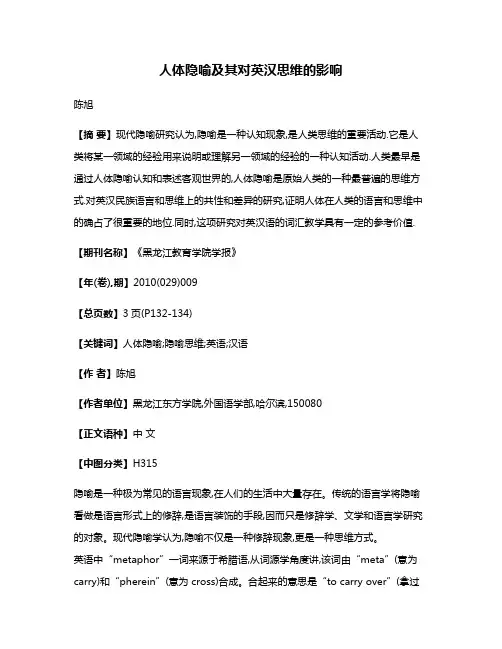
人体隐喻及其对英汉思维的影响陈旭【摘要】现代隐喻研究认为,隐喻是一种认知现象,是人类思维的重要活动.它是人类将某一领域的经验用来说明或理解另一领域的经验的一种认知活动.人类最早是通过人体隐喻认知和表述客观世界的,人体隐喻是原始人类的一种最普遍的思维方式.对英汉民族语言和思维上的共性和差异的研究,证明人体在人类的语言和思维中的确占了很重要的地位.同时,这项研究对英汉语的词汇教学具有一定的参考价值.【期刊名称】《黑龙江教育学院学报》【年(卷),期】2010(029)009【总页数】3页(P132-134)【关键词】人体隐喻;隐喻思维;英语;汉语【作者】陈旭【作者单位】黑龙江东方学院,外国语学部,哈尔滨,150080【正文语种】中文【中图分类】H315隐喻是一种极为常见的语言现象,在人们的生活中大量存在。
传统的语言学将隐喻看做是语言形式上的修辞,是语言装饰的手段,因而只是修辞学、文学和语言学研究的对象。
现代隐喻学认为,隐喻不仅是一种修辞现象,更是一种思维方式。
英语中“metaphor”一词来源于希腊语,从词源学角度讲,该词由“meta”(意为carry)和“pherein”(意为 cross)合成。
合起来的意思是“to carry over”(拿过来,带过来)。
在西方,对隐喻比较系统的研究最早可以追溯到亚里士多德。
他认为:“隐喻是一种修辞手段,用于文学作品当中。
”[1]随着语言学理论的发展,人们认识到了亚氏隐喻定义的局限性。
在其之后,人们对隐喻的研究就从未间断过。
70年代的莱考夫和约翰逊给隐喻的定义为:“隐喻就是通过另一类事物来理解和经历某一类事物。
隐喻不仅属于语言,而且属于思想、行为和活动。
”[2]这就是说,隐喻不仅仅是语言现象,更重要的是一种思维方式。
他们打破了传统的在修辞层面上给隐喻下定义,而是在认知的范畴内定义隐喻,这一点是有积极意义的。
在我国,从 20世纪 80年代起许多语言学家开始对隐喻进行尝试性研究。
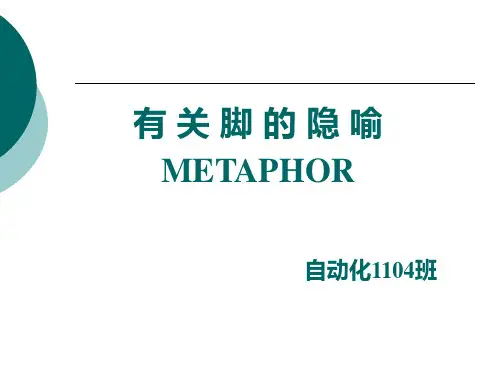


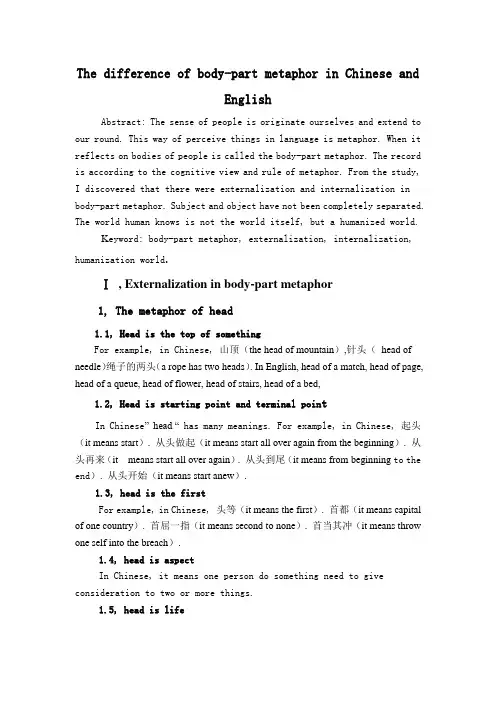
The difference of body-part metaphor in Chinese andEnglishAbstract: The sense of people is originate ourselves and extend to our round. This way of perceive things in language is metaphor. When it reflects on bodies of people is called the body-part metaphor. The record is according to the cognitive view and rule of metaphor. From the study, I discovered that there were externalization and internalization in body-part metaphor. Subject and object have not been completely separated. The world human knows is not the world itself, but a humanized world.K eyword: body-part metaphor, externalization, internalization, humanization world.Ⅰ, Externalization in body-part metaphor1, The metaphor of head1.1, Head is the top of somethingFor example, in Chinese, 山顶(the head of mountain),针头(head of needle)绳子的两头(a rope has two heads). In English, head of a match, head of page, head of a queue, head of flower, head of stairs, head of a bed,1.2, Head is starting point and terminal poin tIn Chinese”head “ has many meanings. For example, in Chinese, 起头(it means start). 从头做起(it means start all over again from the beginning). 从头再来(it means start all over again). 从头到尾(it means from beginning to the end). 从头开始(it means start anew).1.3, head is the firstFor example, in Chinese, 头等(it means the first). 首都(it means capital of one country). 首屈一指(it means second to none). 首当其冲(it means throw one self into the breach).1.4, head is aspectIn Chinese, it means one person do something need to give consideration to two or more things.1.5, head is lifeIn Chinese, 抛头颅洒热血(it means one person contribute his or her life to something). In English, for example it cost him his head. Put one’s head in/into noose.1.6, head is ability of thinkingIn Chinese, for example, 头脑灵活(it means one person is so clever). In English, for example, He is weak in the head. He lost his head. He doesn’t have a head for mathematic. Use your head. The phrase has keep one’s head screwed on the right way. It means the thinking of one person is clearly. Have a good head for something, it means a person can control something.A level head, it means a person is dispassionate. Scratch one’s head, it means one person is confused to something. Go off one’s head, it means one person is crazy. A wolly head, it means one person is confused.1.7, head means personFor example, in English hot head means a person of impatient disposition. A head/per head means everyone or one person.1.8, head is the leader of a groupIn Chinese, 首领,头领,元首,首脑mean a leader of the group. In English, the head of the department and the head of a class.1.9, head is the keyFor example, in English it comes to a head. It means this is very serious moment in time.1.10, head means feelingFor example, in Chinese, 垂头丧气(it means one person’s mood is down).In English, for example, to hold one’s head high, to be off one’s head, to go to somebody’s head, to lose one’s head, hot-headed, to have a swelled head.2, The metaphor of “face”2.1, The face is something or external appearanceF or example, in Chinese 版面(the appearance of the book), 路面(the appearance of the road), 桌面(the appearance of the table),. I n English, face ofa mountain, face of a building, face of the earth, face of a clock.2.2, The face means peopleF or example, in C hinese, 新面孔(it means new people).In English, a new face, different, a famous/well-known face.2.3, Face of a person or organization performance their way to other peopleF or example, in Chinese, 面貌(it means the appearance of one person).In English, the acceptable face of Soviet foreign policy. He may have difficulty persuading the security force to adopt a more human face.2.4, The face is the dignity and reputationFor example, in Chinese, 有面子(have dignity), 要面子(want to have dignity), 丢脸(lose one’s dignity).In English, lose face, save face, have the face to do something.2.5, The face is the focus of interaction and relationshipFor example in Chinese, 当面(face to face).In English, face to face. For example, They call their teacher ’Fatty’, but never to his face.2.6, Face the emotional responseFor example, in Chinese, 愁眉苦脸(it means one person’s mood is down), 笑脸(it means one person is so happy), 脸色(it means complexion). In English, a happy face, a smiling face, an angry face, be double-faced, pull/put on/have/wear a long face.2.7, Face reflected in the spatial domainFor example, in Chinese, 前面(in front of something), 东面(east), 南面(south),西面(west), 北面(north).In English, in the face of , the north face of the mountain.3, The metaphor of “eye”3.1, The eye is the hole of one thingFor example, in Chinese, 龙眼(it means the source of water), 泉眼(it means the source of spring), 枪眼(it means The loophole).In English, the eye of the storm(a storm’s center), eye of potato, eye in a flower, hooks and eyes, eye of a hurricane, the eye of a needle.3.2, Eye means lookFor example, in Chinese, 眼见为实(Seeing is believing), 亲眼所见(see), 眼疾手快(Sharp eyes and agile hands or nimble fingers), 触目惊心(See the scene which is dreadful to one's mind), 一目了然(Stick out a mile).In English, for example, Would you cast your eye over these calculation to check that they are correct. His eyes fell upon an advertisement in the magazine. The government sems to be closing its eyes to the plight of the unemployed. You can’t justshut your eyes to your problems and hope they’ll go away. The manager turneda blind eye when his staff were late.3.3, Understanding is seeIn Chinese, for example, 在我看来(in my opinion), 独具慧眼(Have a special insight understanding), 鼠目寸光(Short-sighted), 世界观(World outlook), 人生观(Outlook on life), 悲观(Pessimism), 乐观(Optimistic), 客观(Objective), 宏观(Macroscopic).In English, for example, In my eyes, it is a very sound investment. The way he deceived me opened my eye to his true character. Developing an eye for a horse is not something which can be taught via a book.3.4, Eye observation, judgment ability of foodFor example, in Chinese, 有眼光(Good taste), 眼高手低(Have grandiose aims but puny abilities).In English, have a good eye for something, to my eye.3.5, For the foreseeable futureFor example, in Chinese, 目标(goal). In English, with an eye to.4, The metaphor of “ear”4.1, Ear means listenFor example, in Chinese, 耳闻(listen),耳熟能详(For having heard it many times), 耳聪目明(Have good ears and eyes).In English, She has sharp ears. He tried to give a sympathetic ear to the patient.4.2, Ear refers to the ability of a thing to understand or judge heardIn English, for example, He has always had a good ear for a tune. I’m proud of my extraordinarily good ear for accents and dialects.5, The metaphor of “nose”5.1, The surface uplift or hole part is the noseFor example, in Chinese, 门鼻儿(The door handle).In English, the nose means the head of train.5.2, The nose means discover or ability to find thingsFor example, in English, He had a nose for a situation. If there was something amiss, he sensed it. He had a nose for trouble and a brilliant tactical mind.5.3, To explore the noseIn English, for example, stick/poke your nose, it means p ut one 's finger into another's pie or To interfere in other people's private affairs.5.4, Nose means find out, the ability to recognizeIn English, for example, have a good nose for, that means A natural at for something.7, The metaphor of “mouth”7.1, Artifacts and figured partIn Chinese, for example, 瓶子口(The opening of the bottle), 碗口(bowl), 窗口(the window). In English, mouth means the opening of bottles.7.2, mouth means Exit and entranceIn Chinese, for example, 洞口(the hole), 火山口(crater), 风口(Tuyere). In English, for example, mouth of a hole, mouth of a tunnel, mouth of a cave, mouth of a river, mouth of a well, mouth of a volcano.7.3, mouth means expressFor example, in Chinese, 口吃(stutter), 口碑(word of mouth), 口才(Eloquence), 口若悬河(Talk rapidly), 口口声声( keep on proclaiming). In English, open your mouth.7.4, mouth means peopleFor example, in Chinese, 拖家带口(Have family burden), 五口之家(a family of five). I n English, a useless mouth, that means foolish. Big mouth is unusual way to use, it means A talkative person.8. The metaphor of “tongue”8,1 The object is extended part of tongueFor example, in Chinese, 帽舌(the visor), 火舌(flames). In English, a tongue of land, a tongue of a flame.8,2 tongue means sayFor example, in Chinese, 饶舌(rap), 舌战(war of words), 费口舌(Waste of breath). In English, slip of tongue, bite one’s tongue, loosen somebody’s tongue, find one’s tongue.8,3 tongue means languageIn English, Latin was for hundreds of years the common tongue to much of Europe.8,4 tongue means the way to talkFor example, in English, She has an acid tongue, she can raise laughs at other people’s expense. He was also by nature an intellectual bully with a cutting tongue.ⅡThe internal organs of metaphor1, The metaphor of “heart”1,1 heart is the center of one thingFor example, in Chinese, 中心(center), 圆心(the heart of the circle), 靶心(the bull’s eye), 球心(the center of the ball). In English, heartland, the heart of the city, the heart of a cabbage.1,2 The heart is a pointed head, shaped like a heart objectsFor example, in Chinese, “V” means Heart-shaped. In English, purple, a kind of dragon.1,3 heart means importantFor example, in Chinese, 心肝(baby).In English, sweet heart, the heart of the matter.1,4 heart means conscienceFor example, in Chinese, 良心(conscience), 扪心自问(Lay the hand on the heart and examine oneself), 问心无愧(feeling no shame). In English, search one’s heart.1,5 heart means courageFor example, in Chinese, 灰心丧气(get disheartened). In English,take/gather heart, to lose heart. In sentences, for example, Take heart, for all is not lost. And, until now he had managed to keep up his classes at the University, but he lost heart for study and dropped out of school.Except that, we can use heart like this, never the heart and keep one’s heart up.1,6 The heart is the carrier of emotionFor example, in Chinese, 心潮澎湃(Be full of excitement ), 扣人心弦(exciting), 心乱如麻(The mind is very confused). In English, when you feel happy and excited, we can use, for one’s heart bleed for somebody, lose one’s heart to somebody, have one’s heart in the right place, wear one’s heart on one’s sleeve. When you feel sad and upset, we can use, break somebody’s heart, for one’s heart to sink, heart-ache, heart tending. When you feel scared, we can use, have one’s heart in one’s boots, have one’s heart in one’s mouth, for one’s heart to miss a beat, for one’s heart to turn.2, The metaphor of “bile”In Chinese, bile means courage. F or example, 胆量(guts), 狗胆包天(Monstrous audacity), 胆大妄为(reckless). In English, bile means have no shame.F or example, have the gall to do something.3, The metaphor of stomach3,1 stomach means interested in somethingIn English, if you want to express the thing is not conform to your hobby, you can use, it goes against my stomach. And if you do not like do something, you can say have no stomach for a fight/talk.3,2 stomach means to bear unpleasant things.F or example, don’t watch that film unless you have a strong stomach.4, The metaphor of visceral4,1 visceral means courage, willpower and determination.In English, She has guts, which is unusual in a young actress.Y ou do not need capital to start in business, you need guts and the absolute belief that you will succeed.4,2 visceral means t he instinctive reactionIn English, gut reaction/feeling/instinct and so on. For example, he had a gut feeling that Sarah was buying. W hen you want to say do something as you feel, we can use at gut level. F or example, she knew at gut level that he was guilty.5, The metaphor of blood5,1 Blood is the main genetic materialIn Chinese, 血缘(Blood kinship). In English, we can use blood as follows: My father regretted that he himself had no Jewish blood. He is got Spanish blood in him. He will be your husband’s closet blood relative.5,2 blood is natural instinctsI n English, we can say as follows: Acting is in her blood. I am a man of the countryside. I t is in my blood.5,3 blood means moodF or example, in Chinese, 热血沸腾(One's blood boils with indignation), 血气方刚(full of sap). In English, bad blood, it means one person is so angry;hot-blooded, it means The mood is very fierce.5,4 blood means peopleFor example: It is good to have some new blood in the department. T he meaning is new persons in the department is a good thing.6, The metaphor of bone6,1 bone means An object plays a supporting roleFor example, in Chinese, 伞骨(bracket of the umbrella).6,2 bone means The most basic contentIn English, if we want to say basic content, we can use the bare bones.F or example: This is just the bare bones of the plan – it is still in theearly stage.6,3 bone means limitF or example, in English, close, it means Someone has said or writtensomething they hate but the truth, so annoying. And something is cut or pared to the bones is means something was decreased greatly.7, The metaphor of nerve7,1 nerve means moodF or example, in English, get on one’s nerve, it means someone is soangry. A nd set one’s nerves on edge is means that the person is so upset.7,2 nerve means courageF or example, in English, have the nerve to do something , it takesa lot of nerve to do something and lose one’s nerve and so on. H ave a nervewas used in oral language. I t means have no shame.Based on the above, The most basic in the metaphor phenomenon of human cognition, metaphor, the most common than body metaphor. Because the basic law of the cognition of the world people are from the near to the distant, from concrete to abstract. While the human is so recent, most closely related to things, so early in the history of human civilization, people around the word know external things always cannot help, without exception, to follow the “in the body, from the objects of law” and it equals to People always put his body including the brain as a measure of the things around, the cognitive experience of human use of other objects of cognition, theconcept of projection for human to another object, so as to construct a new concept for this object. Thus,Human metaphorical thinking is one of the primitive human is one of the most widespread and important way of thinking.11402 027 闫池。
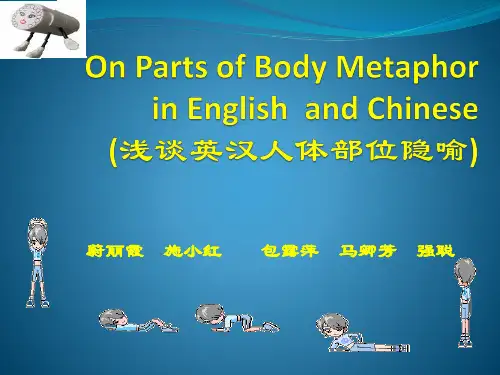
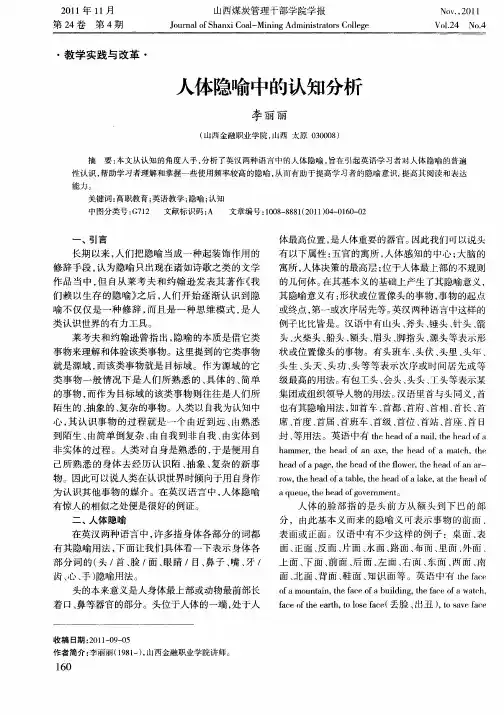
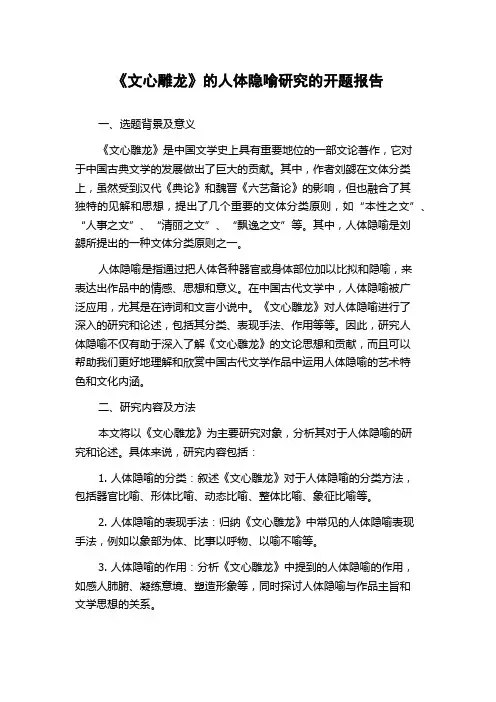
《文心雕龙》的人体隐喻研究的开题报告一、选题背景及意义《文心雕龙》是中国文学史上具有重要地位的一部文论著作,它对于中国古典文学的发展做出了巨大的贡献。
其中,作者刘勰在文体分类上,虽然受到汉代《典论》和魏晋《六艺备论》的影响,但也融合了其独特的见解和思想,提出了几个重要的文体分类原则,如“本性之文”、“人事之文”、“清丽之文”、“飘逸之文”等。
其中,人体隐喻是刘勰所提出的一种文体分类原则之一。
人体隐喻是指通过把人体各种器官或身体部位加以比拟和隐喻,来表达出作品中的情感、思想和意义。
在中国古代文学中,人体隐喻被广泛应用,尤其是在诗词和文言小说中。
《文心雕龙》对人体隐喻进行了深入的研究和论述,包括其分类、表现手法、作用等等。
因此,研究人体隐喻不仅有助于深入了解《文心雕龙》的文论思想和贡献,而且可以帮助我们更好地理解和欣赏中国古代文学作品中运用人体隐喻的艺术特色和文化内涵。
二、研究内容及方法本文将以《文心雕龙》为主要研究对象,分析其对于人体隐喻的研究和论述。
具体来说,研究内容包括:1. 人体隐喻的分类:叙述《文心雕龙》对于人体隐喻的分类方法,包括器官比喻、形体比喻、动态比喻、整体比喻、象征比喻等。
2. 人体隐喻的表现手法:归纳《文心雕龙》中常见的人体隐喻表现手法,例如以象部为体、比事以呼物、以喻不喻等。
3. 人体隐喻的作用:分析《文心雕龙》中提到的人体隐喻的作用,如感人肺腑、凝练意境、塑造形象等,同时探讨人体隐喻与作品主旨和文学思想的关系。
研究方法主要采用文献资料法和文本分析法。
在文献资料法中,主要收集和分析与人体隐喻相关的相关资料和文献,以充分了解人体隐喻的特点和应用。
在文本分析法中,主要选取《文心雕龙》中的相关章节作为样本,通过对样本的细致阅读和分析,深入探讨人体隐喻的分类、表现手法和作用等相关问题。
三、研究预期成果通过此次研究,预期取得以下成果:1. 充分了解、掌握《文心雕龙》中关于人体隐喻的论述和观点,理解刘勰的文学思想和贡献。
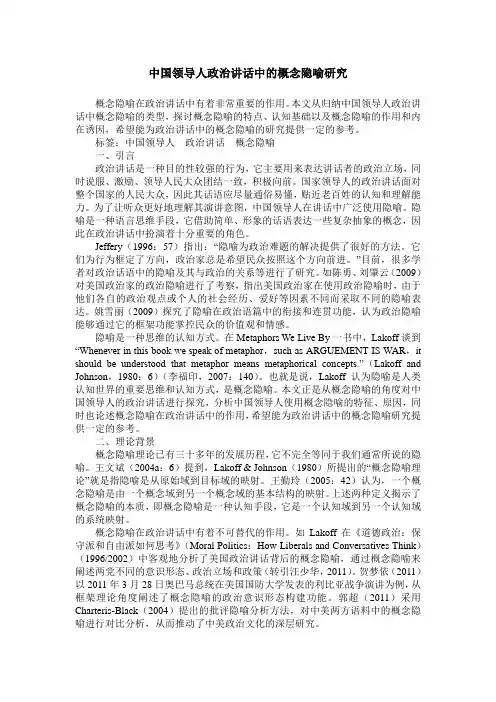
中国领导人政治讲话中的概念隐喻研究概念隐喻在政治讲话中有着非常重要的作用。
本文从归纳中国领导人政治讲话中概念隐喻的类型,探讨概念隐喻的特点、认知基础以及概念隐喻的作用和内在诱因,希望能为政治讲话中的概念隐喻的研究提供一定的参考。
标签:中国领导人政治讲话概念隐喻一、引言政治讲话是一种目的性较强的行为,它主要用来表达讲话者的政治立场,同时说服、激励、领导人民大众团结一致,积极向前。
国家领导人的政治讲话面对整个国家的人民大众,因此其话语应尽量通俗易懂,贴近老百姓的认知和理解能力。
为了让听众更好地理解其演讲意图,中国领导人在讲话中广泛使用隐喻。
隐喻是一种语言思维手段,它借助简单、形象的话语表达一些复杂抽象的概念,因此在政治讲话中扮演着十分重要的角色。
Jeffery(1996:57)指出:“隐喻为政治难题的解决提供了很好的方法。
它们为行为框定了方向,政治家总是希望民众按照这个方向前进。
”目前,很多学者对政治话语中的隐喻及其与政治的关系等进行了研究。
如陈勇、刘肇云(2009)对美国政治家的政治隐喻进行了考察,指出美国政治家在使用政治隐喻时,由于他们各自的政治观点或个人的社会经历、爱好等因素不同而采取不同的隐喻表达。
姚雪丽(2009)探究了隐喻在政治语篇中的衔接和连贯功能,认为政治隐喻能够通过它的框架功能掌控民众的价值观和情感。
隐喻是一种思维的认知方式。
在Metaphors We Live By一书中,Lakoff谈到“Whenever in this book we speak of metaphor,such as ARGUEMENT IS WAR,it should be understood that metaphor means metaphorical concepts.”(Lakoff and Johnson,1980:6)(李福印,2007:140)。
也就是说,Lakoff认为隐喻是人类认知世界的重要思维和认知方式,是概念隐喻。
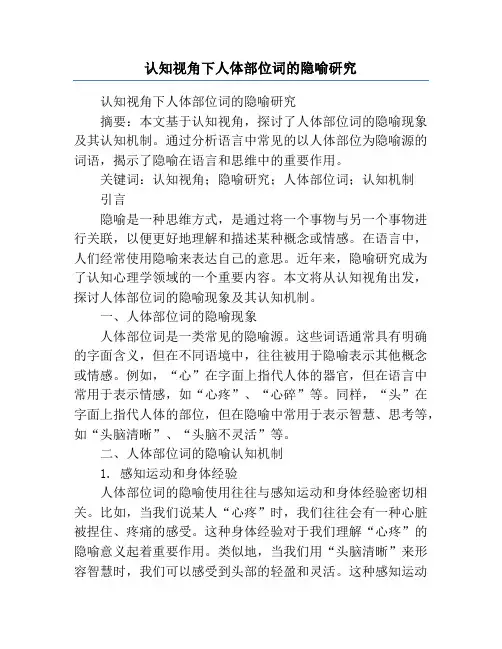
认知视角下人体部位词的隐喻研究认知视角下人体部位词的隐喻研究摘要:本文基于认知视角,探讨了人体部位词的隐喻现象及其认知机制。
通过分析语言中常见的以人体部位为隐喻源的词语,揭示了隐喻在语言和思维中的重要作用。
关键词:认知视角;隐喻研究;人体部位词;认知机制引言隐喻是一种思维方式,是通过将一个事物与另一个事物进行关联,以便更好地理解和描述某种概念或情感。
在语言中,人们经常使用隐喻来表达自己的意思。
近年来,隐喻研究成为了认知心理学领域的一个重要内容。
本文将从认知视角出发,探讨人体部位词的隐喻现象及其认知机制。
一、人体部位词的隐喻现象人体部位词是一类常见的隐喻源。
这些词语通常具有明确的字面含义,但在不同语境中,往往被用于隐喻表示其他概念或情感。
例如,“心”在字面上指代人体的器官,但在语言中常用于表示情感,如“心疼”、“心碎”等。
同样,“头”在字面上指代人体的部位,但在隐喻中常用于表示智慧、思考等,如“头脑清晰”、“头脑不灵活”等。
二、人体部位词的隐喻认知机制1. 感知运动和身体经验人体部位词的隐喻使用往往与感知运动和身体经验密切相关。
比如,当我们说某人“心疼”时,我们往往会有一种心脏被捏住、疼痛的感受。
这种身体经验对于我们理解“心疼”的隐喻意义起着重要作用。
类似地,当我们用“头脑清晰”来形容智慧时,我们可以感受到头部的轻盈和灵活。
这种感知运动和身体经验帮助我们将人体部位词与其他概念或情感进行关联。
2. 回忆和经验积累隐喻往往依赖于个体的回忆和经验积累。
人们通过长时间的语言和文化传承,将某些人体部位与特定概念或情感关联起来。
这些关联会在个体的语言运用和思维过程中产生影响。
例如,“手”经常被用于表示援助和帮助,这可能与我们在婴儿时期接受到的依赖和帮助有关。
这种回忆和经验积累为我们理解和使用人体部位词的隐喻意义提供了基础。
3. 集体文化价值观隐喻现象不仅与个体的经验和认知有关,也与集体的文化价值观密切相关。
不同文化对于人体部位词隐喻的使用和理解可能存在差异。
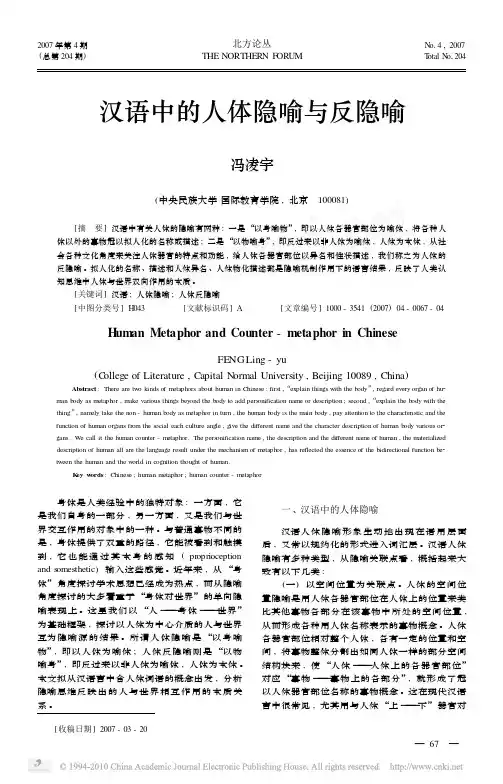
汉语中的人体隐喻与反隐喻冯凌宇(中央民族大学国际教育学院,北京 100081)[摘 要]汉语中有关人体的隐喻有两种:一是“以身喻物”,即以人体各器官部位为喻体,将各种人体以外的事物冠以拟人化的名称或描述;二是“以物喻身”,即反过来以非人体为喻体,人体为本体,从社会各种文化角度来关注人体器官的特点和功能,给人体各器官部位以异名和性状描述,我们称之为人体的反隐喻。
拟人化的名称、描述和人体异名、人体物化描述都是隐喻机制作用下的语言结果,反映了人类认知思维中人体与世界双向作用的本质。
[关键词]汉语;人体隐喻;人体反隐喻[中图分类号]H043 [文献标识码]A [文章编号]1000-3541(2007)04-0067-04H uman Metaphor and Counter -metaphor in ChineseFE NGLing -yu(C ollege of Literature ,Capital Normal University ,Beijing 10089,China )Abstract :There are tw o kinds of metaphors about human in Chinese :first ,“explain things with the body ”,regard every organ of hu 2man body as metaphor ,make various things bey ond the body to add pers onification name or description ;second ,“explain the body with the thing ”,namely take the non -human body as metaphor in turn ,the human body is the main body ,pay attention to the characteristic and the function of human organs from the s ocial each culture angle ,give the different name and the character description of human body various or 2gans.W e call it the human counter -metaphor.The pers onification name ,the description and the different name of human ,the materialized description of human all are the language result under the mechanism of metaphor ,has reflected the essence of the bidirectional function be 2tween the human and the w orld in cognition thought of human.K ey w ords :Chinese ;human metaphor ;human counter -metaphor[收稿日期]2007-03-20 身体是人类经验中的独特对象:一方面,它是我们自身的一部分,另一方面,又是我们与世界交互作用的对象中的一种。
汉●语●人●体●部●位●特●征●的●隐●喻●研●究● ○程淑贞一汉语中有很多以人体部位名称指称事物、阐明事理的语汇,它们以各种不同的表达形式出现,或词,或成语,或警句、民谚、格言、惯用语等,而且从头到脚,从衣饰到行为动作,几乎无所不包。
大致罗列一下,基本有下面几类:(一)以人体不同部位的名称为语素,采用拟人方式构成事物的概念名称。
如:山头 枝头 首都 山顶 树顶 龙头 针眼 炮眼 泉眼 枪眼壶嘴 壶肚 壶口 喷嘴 窗口 路口 山口 风口 谷口 门口锯齿 轮齿 书眉 火舌 帽舌 项目 水喉 车身 河身 圆心中心 鼎足 山腰 山脚 山腹 山脊 山脉 瓶颈 瓶口 瓶腹针鼻儿 门鼻儿(二)以人体部位名称或与人体有密切关系的衣服饰物等名称,通过借代、比喻、比拟等方式形成词语,以喻指事物或概念。
如:头脑、头目、头颅、首领———喻指集团或部门的负责人;耳目、眼目———喻指替人刺探消息的人;辫子———指人的把柄;首尾———指事情的起末;手足———喻指兄弟姐妹;骨肉———指父母兄弟子女等亲人;骨血、后裔———指后代;骨干———喻指总体中起主要作用的人或事物;头角———喻指青年的才华、气概;皓首———代指老年人;手脚———指暗中作弊;心腹———喻指人的亲信;手臂———喻指人的助手;手腕———喻指人的本领或能耐;眼珠子———喻最珍爱的人或物;咽喉———喻指人的本领或能耐;眼珠子———喻最珍爱的人或物;咽喉———喻指形势险要的交通孔道;心脏———比喻中心位置;头面———旧时喻指妇女头上饰物的总称;股肱———喻指国家重臣;蛾眉———指女子;须眉———指男子;布衣———代指平民百姓;裙衩、巾帼———代指妇女;便衣———代指穿便装执行公务的军人、警察等;连襟———喻指姐妹们的丈夫之间的亲属关系;粉黛———喻指妇女;缙绅———旧指有官职或做过官的人;乌纱帽———喻指官员。
(三)以人体部位的特征、状态,或行为动作等来描述事物、比喻事理。
人体器官名词的隐喻与转喻研究人是社会的核心,语言是社会的产物,因此在汉语中存在着大量与人体有关的词语。
今天,这些词语已不再单单指称人体器官,而是被赋予了新的意义。
本文从认知语言学的角度,对人体器官名词的语义从隐喻和转喻两方面进行了分析,进一步说明了人体词语隐喻和转喻的系统性及形成。
标签:人体器官名词隐喻转喻机制系统为了满足人类交流的需要,语言应运而生。
人体词语作为名词与汉语里普通名词一样具有语义的共时性和历时性、多义性和文化性,除此之外,人体词语还具有隐喻性和转喻性两个个性语义特征。
其中,人体词语的隐喻性包括对外界事物整体的隐喻和对人体部位的部分隐喻两个方面;人体词语的转喻性包括人体词语转指人、转指长度单位、转指人体相应部位的特征或功能、转指人体部位相应的动作行为四个方面。
一、人体词语与普通名词的共性语义特征(一)客观性语义的内容来源于客观世界中客观存在的事物,所以语义是客观的。
正是因为世界上客观存在“山、人、狗”等事物或现象,人们才有可能通过认识形成相应的概念从而创造出表现这些概念的音义结合词来。
“头”这个词之所以“是人体的最上部分或动物的最前部分,长着口、鼻、眼等器官”,是由“头”这个器官的特点决定的。
古代典籍中没有“人造卫星”“电脑”这些词,因为这些事物在古代不是客观存在的。
(二)历时变化性语义的历时变化由两方面原因形成。
一方面源于客观世界的发展变化,词义以客观世界为内容,客观世界的变化必然引起语义的变化。
《汉语大词典》列出的“心”的15个义项中有14个义项呈现出从具体到抽象的演变过程。
前三个义项为具体的器官实物义项——“心脏:人和脊椎动物体内血液循环的肌性器官”“心脏所在的部位泛指胸部”和“胃部”。
另外有三个义项体现了从实物义到非实物义之间的过渡:“木上的尖刺、花蕊或草木的芽尖等”“某些点心的馅子,如包子心、饺子心”“中心,中央”。
这是人们由心脏在人体所处的位置而联想到外界处于中心位置的具体事物。
英汉语人体隐喻对比与跨文化差异摘要:当代认知学家认为,隐喻不仅是一种语言现象,而且反映了人类的认知规律,是一种认知现象。
人类由近及远,由实体到抽象,有简单到复杂的认知规律决定了人体及其器官是人类认知世界的基础,因而人体隐喻是人类普遍存在的认知方式。
英汉隐喻表达也存在一定差异,主要体现在以下几方面:自然与地理环境差异;视点差异;语言文化差异;传统文化差异。
关键词:隐喻;人体隐喻;投射;跨文化差异一、隐喻和人体隐喻传统的语言学将隐喻研究局限于修辞层和语言层,认为隐喻是语言形式上的修辞,是一种语言现象。
而当代认知语言学则认为,隐喻不仅仅是语言现象,而且是一种重要的认知方式。
概念隐喻是Lakoff 隐喻理论提出的一个重要概念。
人类赖以生存的许多基本概念系统以及人类思维方式和行为方式本质上都是隐喻性的。
概念隐喻是以人类身体经验为基础加以形成的,因此人体及其器官在人类认知发展过程中有着重要的地位。
由于人类的认知遵循由近及远,由实体到抽象,由简单到复杂的规律,人类最熟悉自己的身体,因此为了达到认识陌生事物的目的,人类最初把自身身体的认识作为始源域,投射到不熟悉的、抽象的目标域,语言中也就产生了大量的人体隐喻性表达。
二、英汉语人体隐喻的投射类型Lakoff和Johnson在《我们赖以生存的隐喻》一书里提出了“域”的概念,隐喻可以看成是两个概念域或认知域之间的结构投射,即从始源域向目标域的投射。
隐喻认知则是在始源域和目标域所建立的投射关系的基础上形成的,在始源域和目标域之间存在一种互动关系。
根据始源域和目标域的不同,人体隐喻主要有三种类型:人体域投射到非人体域,非人体域投射到人体域和人体域内部两个域的投射。
1.人体域投射到非人体域,即始源域是身体部分从人体域到非人体域的投射是建立在两者概念相似性的基础上。
人们最熟悉自己的身体,于是在早期认识世界的过程中会借用身体及其部位去描述其他具体的事物。
汉语中就有很多这样的表达:“山头”、“山脊”、“山腰”、“山脚”、“洞口”、“树冠”、“泉眼”、“桌腿”、“桌面”、“扶手”、“壶嘴”、“果皮”等。
人体隐喻的发展历程
人类文明的发展过程中,人体隐喻的运用日渐丰富和深入。
人体作为我们身体的一部分,承载着生命、情感、思维等丰富的意义,自古以来就成为各种语言、文学、艺术表达中的重要元素。
下面将从古代到现代,简要介绍人体隐喻的发展历程。
在古代文学和哲学中,人体隐喻起到了重要的表达作用。
古代中国文化中,人体被用作象征的载体,以表达人性、道德价值观等。
诸如“心如古井”、“肺腑之言”等,将人的内心情感与身
体器官进行类比,以增强表达的鲜明性和感染力。
随着时代的变迁,人类探索知识和艺术的边界越来越深入,人体隐喻的运用也逐渐丰富和多样化。
文艺复兴时期的欧洲文学中,人体隐喻被广泛应用于诗歌、绘画和雕塑等艺术形式中。
例如,米开朗基罗的名作《大卫像》中,大卫的身体被塑造得强健有力,象征着勇气和意志的坚定。
进入现代,人体隐喻的运用更加广泛和多样化。
在现代诗歌中,人体隐喻常常被运用来表达复杂的情感和意象。
诗人可以借助对手掌、眼睛、脚步等身体部位的描写,来表达内心的思绪和情感体验。
同时,在广告和媒体等领域,人体隐喻也得到广泛运用。
例如,某品牌的广告语“抱一抱更暖心”,将人的拥抱与亲近、关爱等情感联系在一起,以吸引消费者的共鸣和认同。
总体而言,人体隐喻是人类语言和文化发展的产物,它通过将人体与丰富的意义相联系,丰富了文学、艺术和广告等领域的
表达方式。
它不仅起到了传递信息和情感的作用,还帮助我们更好地理解和感知世界。
人体的隐喻(十)
子宫
1
子宫是人类最早的地址。
子宫是人类最初的故乡。
说子宫是一个器官,其实它是一个真正的场所,空间,地理,家园。
每一个人从这里出发,通过成长,到达他想去的各种远方。
子宫是起点,人们描述这个起点却显得词穷,因为在起点里面,人们几乎没有记忆,人们也不知道这座最早容纳自己的房子,它家徒四壁的设施,它的幽暗,它的恒温,它的柔软,以及它这十个月里在一些陌生之地的移动。
作为房子,人的身体在这里得到充分的雕琢和打磨,先是头颅和躯干,然后是手、脚,手渐渐又分化出手指,手指上又长出柔软的指甲;在内部,身体也在雕琢自己,它给自己装上了
胃、脾和肾,安上了小小的生殖器,给自己布置一些细细的血管和神经。
当然,这一切只是粗加工,很多部件要到离开子宫后才能真正形成,有些细节需要考验后才能铸成,而有些缺损则必须时间来将它消除。
在子宫里,身体不过是完成它的一个雏形,好使它运转起来。
人体在这个时候,是某种确定无疑的混沌的结合物,一方面,它的宿命已经像秤砣一样沉下来,另一方面,它的很多器官却还在生长中,它的脸也没有个性,在子宫里,所有的胎儿长得都很像。
可以说,在每个成年女人的身体里,都悬着这样一座育婴房和人体雕塑工作室。
女人带着她的子宫就像带着她内部的一个异体,因为子宫是幢独立的建筑,在建筑里面,它自身有一个可以循环的系统,同时,从问世的那一天起,这个系统就要和她脱离关系,经过产道那条又黑又长的弄堂,经过钳子、刀具的粗暴拨弄之后,这个系统来到一个充满空气和焦虑的世界门口,之后它被放到一个小小的托盘上,它的第一次思考就是关于怎么向世界表态,由于它掌握的动作技能和经验不多,它本来想对世界说“你好”,可发出来的声音却是一阵令
人头痛的长嚎。
不过携带子宫的那个成年女人接纳了它,同时接纳它的还有在一边忙了好几个小时的医生护士和那几把钳子。
就这样,一个生命开始了。
对于这个新生命自身来说,它也是一个异体。
加缪在《西绪弗斯神话》里说:在一个突然被剥夺了幻象和光芒的宇宙中,人看起来是异邦的,是陌生人。
他的流亡无法医治,因为他被剥夺了一个失去的故乡或一片应许之地的记忆。
对于这个新生命来说,它是因为被给予了光芒和故乡而成为自己的陌生人的,它忽然发现,自己成了一个具体的人,有着具体的面貌,有着深重的呼吸,会哭,会笑,不久之后它还将掌握语言,以便同其余的人沟通。
同时,光线让它看见了很多东西,每一次看见都是陌生的,每一秒钟看见的东西,一秒钟后就不一样了,也就是说,它看见的世界没有一秒钟是相同的。
它生活在自己的异体里。
关于故乡,那也是一个虚拟的概念,充其量它只是一个地址,因为对于子宫它没有记忆和幻象,它“失去”了故乡,在很长的时间里,它还将在种危险的地方四处移动……
2
子宫的幽闭就是一幢建筑。
无论是把子宫看作豪华宫殿也好,世界上最简陋的房子也好,都是因为我们生命的最初十个月都是在那里度过的。
子宫每次通常允许一两名房客入住,因为子宫有意培养人们对付孤寂的能力。
子宫的房客有史以来,记录最多的是十五名,但由于营养不良,这十五名房客最后全军覆没,为了争取自己那点小小的生存空间而英勇捐躯。
1964年,巴西一名叫萨达路的农妇让这份纪录有了新的篇章,她在她腹内的方寸之地招待了十名顾客,八位女士和两位先生,并让他们幸存下来。
十个月之后,这群活蹦乱跳的房客告别这座拥挤不堪的子宫房子,兴致勃勃地来到外面叩见他们举世无二的母亲。
3
我们在子宫里学会了很多技能:自我完善的能力,等待的能力,聆听的能力,自省的能力,独处的能力。
这十个月,对于大多数人来说,子宫并非一间乏味的单人牢房,因为我们间接地在这里接纳着即
将与我们晤面的世界:模模糊糊的光亮,隐隐约约的声音,若即若离的危险,我们注意力的重心每天被它们撩拨着,在撩拨之间,我们学会了傾听和等待,之后是想象的能力,超越自我的能力,以及在很久之后才会用到的面壁思过的能力。
我们出去后并不是一直生活在人群里的,所以我们掌握这些技能利于同自己相处,特别是我们像接纳自己的肢体一样接纳了孤独,我们必须对这样的一项能力进行确认,不论我们今后与谁走在一起,都避免不了这件装备,它们是造物主为我们定制的“皇帝的新衣”,只有我们的同类才能看到。
等我们出来后,不论与谁相爱,我们与对方都不过是两支靠近的蜡烛,烛光可以合而为一,但之后其中的一支还是可以与另一支分开,我们与对方仍旧是两只蜡烛。
越是深爱的人越孤独,因为深爱的人为了装上对方的形象,把自己都清空了,他(她)对对方的爱就像光,满到只有光了之后,就碰不到任何物体了,包括他自己。
光此时犹如黑暗。
4
女人带着子宫,就像带着起点,开始,变化,带着一间会客室,
带着纪念,带着更新,带着不可知,带着未来。
在性交时,女人像场所那样是被动的;在孕育时,她就变成了主动,变成了一种功能,一个方法,一个渠道,一次出击。
是子宫使女人成为一个保存和创新自然界的价值与能量的角色的,在这方面,男人则只是消耗,一个纯粹的消费者。
男人的身体更像是一架机器,重复地、周而复始地运动,却不产生点什么。
而几乎每一个女人都带着一个无限的宇宙,在她的身体里,有一扇朝向未来打开的窗户,不可计数,无穷无尽,它形状封闭,却不可丈量。
在人类的关系里,女人就是那样一种事物,她是一种装饰物,丰富,被动,容纳却又不融合。
在男人的生活中,她像帕斯在《孤独的迷宫》中形容在美国的墨西哥的气味,她“飘荡,却不反抗;它被风吹着保持着平衡,有时像云雾一样消散,有时像升天的火箭一样突现出来。
它匍匐,重叠,膨胀,收缩,入睡或进入梦乡,支离破碎的美。
飘荡:不停地存在,不停地消失”。
子宫,让女人不停地存在,不停地消失。
子宫让人类不停地存在,
不停地消失。
牙齿
1
牙齿是我们人体里唯一的物种。